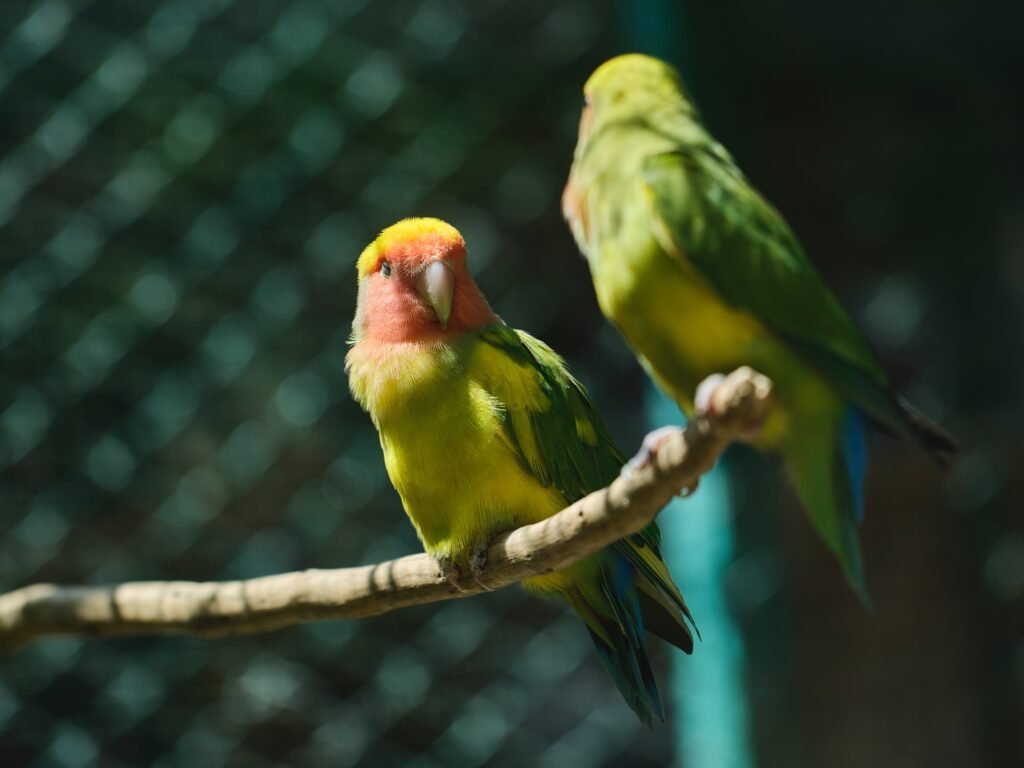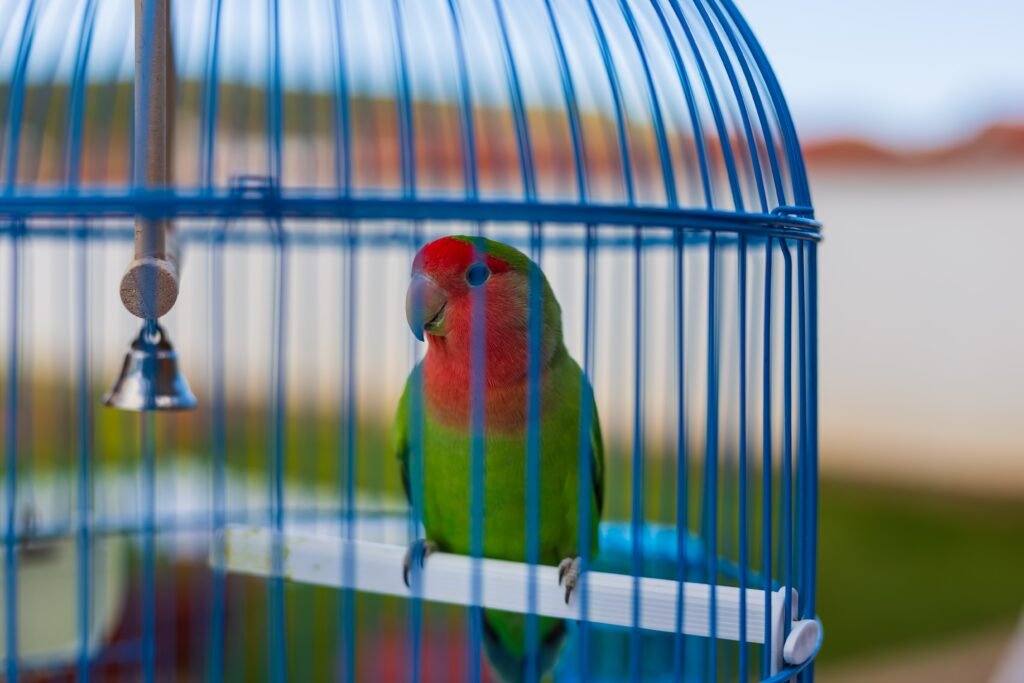Lovebirds are enchanting and charismatic birds that make wonderful companions for bird lovers. Among the various lovebird species, the Lovebird Blue is particularly captivating with its stunning blue plumage and affectionate nature. In this article, we will delve into the intriguing world of Lovebirds Blue, providing valuable insights into their care requirements and behavior tips.
Introduction to Lovebirds Blue
Lovebirds Blue, also known as the Madagascar Lovebird or the Abyssinian Lovebird, is a small parrot species native to the island of Madagascar. They are named after their vibrant blue feathers, which adorn their bodies in a captivating and unique manner. These birds are popular among bird enthusiasts for their endearing personalities and striking appearance.
Lovebirds Blue are known for their friendly and affectionate nature. They form strong bonds with their owners and enjoy spending time interacting with them. These birds are highly social and thrive on companionship, making them excellent pets for individuals or families looking for a feathered companion. Their captivating blue plumage adds to their charm and makes them a delightful addition to any bird lover’s home.
Physical Characteristics
Lovebirds Blue are small-sized parrots, measuring around 5 to 7 inches in length. Their most distinguishing feature is their beautiful blue plumage, which ranges from deep cobalt blue to a lighter turquoise shade. The vibrant coloration of their feathers is a result of a genetic mutation called “blue series.”
In addition to their stunning blue feathers, Lovebirds Blue have a stocky build with a short tail and a strong curved beak. Their beak is specially adapted for cracking open seeds and nuts, which are a staple of their diet. These birds also have strong feet that allow them to grasp onto perches and climb around their environment with ease.
Housing and Cage Requirements
Providing a suitable living environment is essential for the well-being of Lovebirds Blue. Here are some housing and cage requirements to consider:
- Cage Size: Lovebirds Blue thrive in spacious cages that allow them to exercise and play. A cage measuring at least 24 inches in width, 18 inches in depth, and 24 inches in height is recommended. The larger the cage, the better, as it provides more room for the birds to move around and stretch their wings.
- Bar Spacing: The bars of the cage should be no more than 1/2 inch apart to prevent the birds from escaping or getting their heads stuck. Lovebirds Blue are curious and agile, so it’s important to ensure that the cage is escape-proof.
- Perches: Offer multiple perches of varying diameters within the cage to promote healthy foot exercise. Lovebirds Blue enjoy climbing and perching on different surfaces, so providing a variety of perches will keep them physically active and engaged. Natural branches can be used as perches, as long as they have not been treated with any harmful substances.
- Toys and Enrichment: Lovebirds Blue are active and intelligent birds that require mental stimulation. Provide them with a variety of toys such as bells, swings, and puzzles to keep them engaged and entertained. Rotate the toys regularly to prevent boredom and introduce new challenges for their curious minds.
- Location: Place the cage in a draft-free area away from direct sunlight and extreme temperature fluctuations. Lovebirds Blue prefer a calm and quiet environment, so avoid placing their cage in high-traffic areas. It’s also important to ensure that the cage is not placed near any household hazards or areas with toxic fumes.
Diet and Nutrition
Maintaining a balanced and nutritious diet is crucial for the health and longevity of Lovebirds Blue. Here are the dietary requirements to meet:
- Pelleted Diet: A high-quality pelleted diet specifically formulated for Lovebirds Blue should be the staple of their diet. These pellets contain essential nutrients and vitamins that support their overall well-being. Pellets provide a balanced and complete nutrition source for Lovebirds Blue and help prevent selective eating habits.
- Fresh Fruits and Vegetables: Supplement the pelleted diet with a variety of fresh fruits and vegetables. Offer a daily serving of leafy greens, such as spinach or kale, along with fruits like apples, berries, and oranges. These fresh foods provide additional vitamins, minerals, and antioxidants that contribute to the birds’ overall health.
- Seeds and Grains: Lovebirds Blue enjoy eating seeds and grains as part of their diet. However, it is important to offer them in moderation, as they can be high in fat. Good options include millet, sunflower seeds, and quinoa. These can be provided as occasional treats or used as a foraging activity to keep the birds mentally stimulated.
- Cuttlebone and Grit: Provide a cuttlebone in the cage to supply calcium, which is essential for strong bones and beak health. Grit, such as small crushed stones, can be offered to aid in digestion. However, it’s important to note that Lovebirds Blue do not require grit if they have access to a balanced diet that includes pelleted food.
Socialization and Behavioral Tips
Lovebirds Blue are highly social birds that thrive on interaction and companionship. Here are some tips to ensure their emotional well-being:
- Pair Bonding: Lovebirds Blue are monogamous birds that form strong pair bonds. If you decide to keep a pair, it is important to introduce them at a young age to facilitate bonding. Ensure that the birds get along well and exhibit compatible behavior. If keeping a single Lovebird Blue, make sure to provide ample social interaction and companionship to prevent loneliness.
- Human Interaction: Regular human interaction is crucial in order to build trust and a strong bond with your Lovebirds Blue. Spend quality time with them outside the cage, allowing them to explore and interact with their environment. Talk to them softly and offer treats as a form of positive reinforcement. With consistent and gentle handling, Lovebirds Blue can become quite tame and affectionate.
- Playtime and Enrichment: Lovebirds Blue are playful and curious by nature. Provide them with plenty of toys and opportunities for playtime outside the cage. This can include providing bird-safe materials for them to chew on, swings for them to swing on, and puzzles or foraging toys to keep their minds stimulated. Additionally, allowing them supervised time outside of the cage in a safe and bird-proofed area can provide them with additional mental and physical exercise.
- Vocalizations: Lovebirds Blue are known for their vocalizations, which include chirping, squawking, and mimicking sounds. Embrace their natural vocal abilities and provide positive reinforcement when they exhibit desired behaviors. However, if their vocalizations become excessive or bothersome, it’s important to redirect their attention to other activities or provide them with quiet time to prevent stress or annoyance.
Common Health Issues
To ensure the well-being of your Lovebirds Blue, it is important to be aware of potential health issues. Some common health concerns specific to Lovebirds Blue include:
- Feather Plucking: Lovebirds Blue may engage in feather plucking due to stress, boredom, or health issues. Provide a stimulating environment, a balanced diet, and seek veterinary advice if excessive plucking occurs. It’s important to address the underlying cause and provide appropriate solutions to prevent further feather damage.
- Respiratory Infections: These birds are susceptible to respiratory infections, especially when exposed to drafts or poor air quality. Keep their environment clean, avoid smoking around them, and seek veterinary care at the first sign of respiratory distress. Regular cleaning of the cage and providing fresh air circulation can help minimize the risk of respiratory infections.
- Psittacosis: Lovebirds Blue are also susceptible to psittacosis, a bacterial infection that can be transmitted to humans. Regular veterinary check-ups and proper hygiene practices are essential in preventing and detecting this disease. It’s important to wash hands thoroughly after handling the birds or cleaning their cage, and to seek immediate veterinary attention if any signs of illness, such as lethargy or loss of appetite, are observed.
Conclusion
Lovebirds Blue are fascinating creatures that make delightful pets for those willing to provide them with the care and attention they require. By understanding their housing needs, dietary requirements, socialization, and potential health issues, you can ensure a fulfilling and enriching experience with these captivating birds. Invest time and effort into creating a nurturing environment for your Lovebirds Blue, and you will be rewarded with their affection, charm, and the joy they bring to your life.
FAQ
- What is the Lovebird Blue?
Lovebird Blue, also known as the Madagascar Lovebird or the Abyssinian Lovebird, is a small parrot species native to the island of Madagascar. They are named after their vibrant blue feathers, which adorn their bodies in a captivating and unique manner.
- What are the housing and cage requirements for Lovebirds Blue?
Lovebirds Blue thrive in spacious cages that allow them to exercise and play. A cage measuring at least 24 inches in width, 18 inches in depth, and 24 inches in height is recommended. The bars of the cage should be no more than 1/2 inch apart to prevent the birds from escaping or getting their heads stuck. Offer multiple perches of varying diameters and provide a variety of toys for mental stimulation. Place the cage in a draft-free area away from direct sunlight and extreme temperature fluctuations.
- What is the diet and nutrition for Lovebirds Blue?
Lovebirds Blue should have a high-quality pelleted diet as the staple of their diet. Supplement their diet with fresh fruits and vegetables, and offer seeds and grains in moderation. Provide a cuttlebone for calcium supply and grit for digestion, if necessary.
- How can I ensure the emotional well-being of Lovebirds Blue?
Lovebirds Blue are highly social birds. If keeping a pair, introduce them at a young age to facilitate bonding. Provide regular human interaction, spend quality time with them outside the cage, and offer treats as positive reinforcement. Provide plenty of toys and opportunities for playtime and mental stimulation. Embrace their vocalizations and redirect their attention if necessary.


